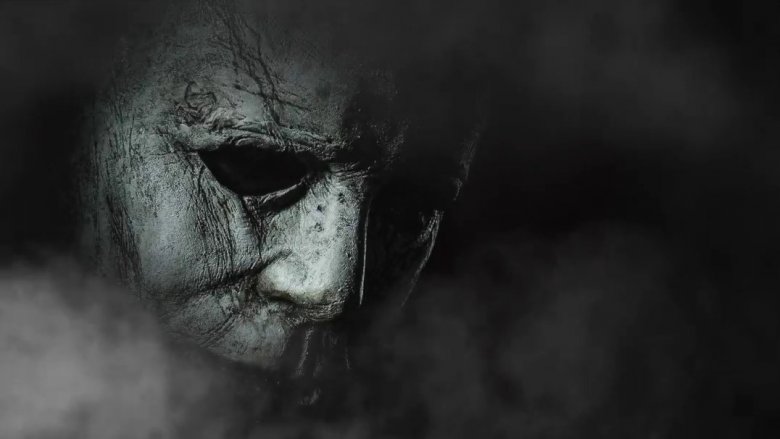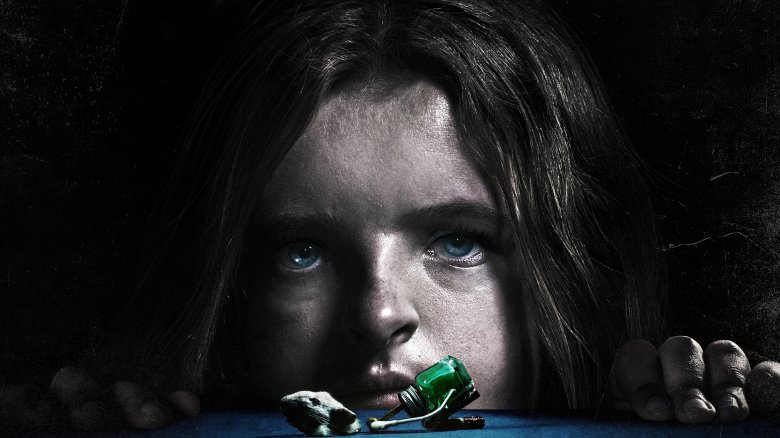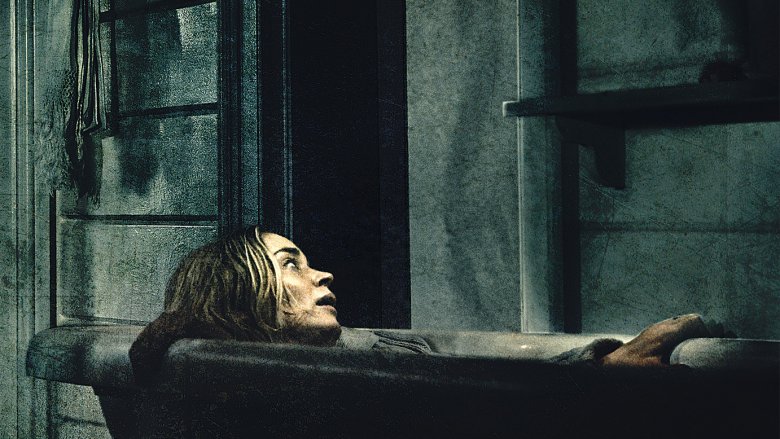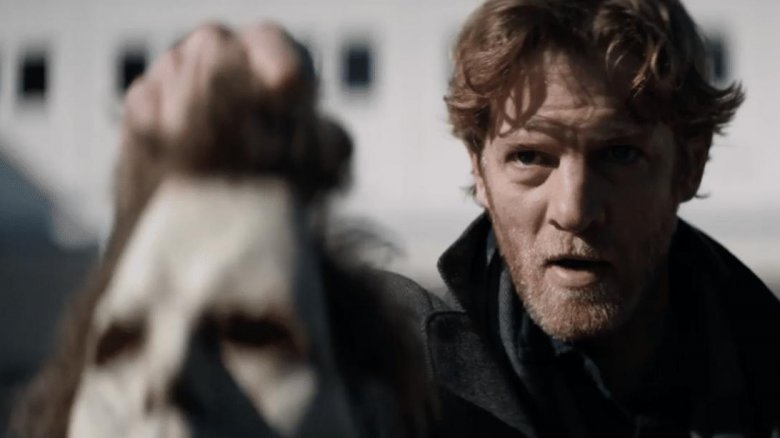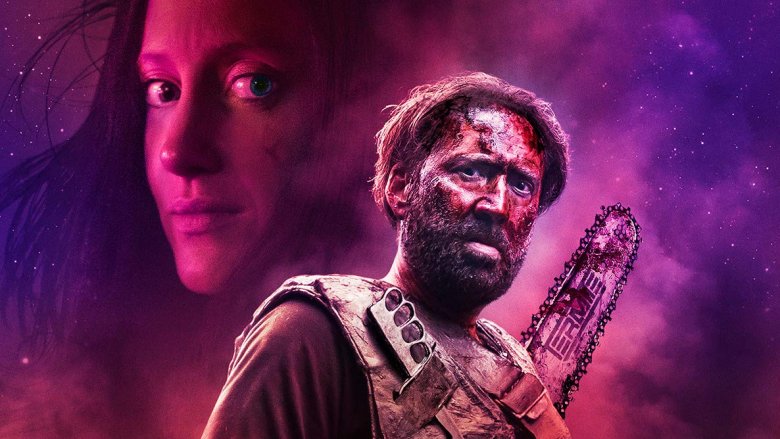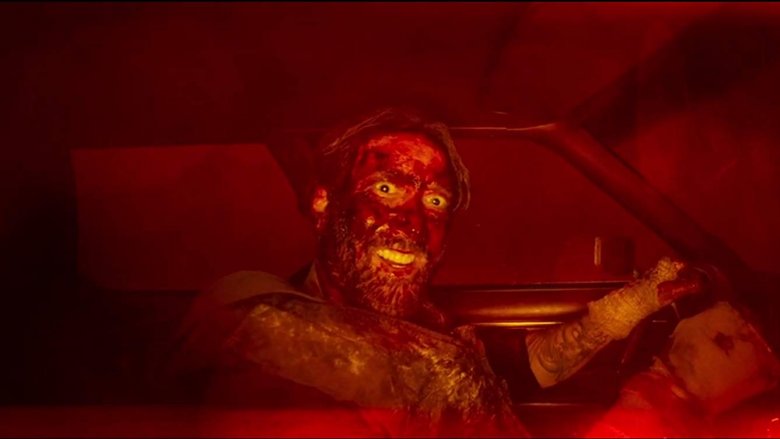The Best Horror Movie Of 2018 Is Not What You Think
Despite what you might have heard from Vogue magazine when they decided to pontificate about horror movies for a minute, 2018 was actually a pretty good year for the horror genre. There were so many good films of the horror and horror-adjacent oeuvres that it would be basically impossible to keep up with them all, even if you were really trying.
The styles were wide and ranging, from the Nazi zombie madness of Overlord to the filmed-on-an-iPhone psychological suspense of Unsane to the subtle, "this ghost story is actually about the evolution of class structures in post-war Britain" Masterpiece Theatre sensibilities of The Little Stranger. There were indie gems like Summer of '84 and Ghost Stories, but even wide-release franchise sequels like The First Purge and Unfriended: Dark Web came out blazing and improved on their series. You had thought-provoking sci-fi horror like Upgrade and Annihilation as well as folk horror in the form of Gareth Evans' Apostle, plus stunning foreign horror films making their English-language debuts in 2018.
That's a lot of good stuff to choose from, which is maybe not surprising given how movies like The Nun are burning up the box office and well-crafted spookums are starting up those tired "this horror movie is so good, maybe it's not actually horror" discussions among critics. But between box office boffo and the certified fresh, what's the best horror flick of the year?
When the obvious is too obvious
To be 100 percent completely honest, the best horror movie of 2018 is Hereditary and it's actually not even close. It is the movie of 2018 that a decade from now people will be discussing in the same breath as The Exorcist and The Shining. But unfortunately, we can't give it the honors here.
Yes, the plot is as tightly crafted as a spring wound to its breaking point, the visual style is innovative and deftly employs visual metaphor in a way that's not distracting, and an atmosphere of dread hangs over the whole affair like miasma of black mist. Then there are the performances: stirring, powerful, terrifying. It will be an actual, punishable by up to five years in prison crime if Toni Collette does not win best actress for this movie. Oh, and also it's scary as hell.
So what's the issue? Why is this not number one? Well, in short, people don't like it. Despite being popular with critics — it has the highest score on Metacritic of any horror movie in 2018 – Hereditary has the abysmal CinemaScore (which comes from polling movie viewers) of D+, worse than both Hell Fest and Truth or Dare, which are actually very bad movies. If you played this at your Halloween party, there's a solid chance your friends would be confused and potentially very angry, claiming "the ending came out of nowhere" despite literally every frame of the film careening inevitably to that final scene.
Is bigger better?
Okay, then, what about a movie people did like? Is there one that got good reviews and was popular with viewers? It turns out, in fact, the highest grossing horror movie of 2018 is also the horror movie with the highest Rotten Tomatoes score at an impressive 95 percent. While these metrics are not infallible by any means, they can help give a broad impression that a movie is, in fact, pretty watchable. You might have heard of this one: it's called A Quiet Place.
You remember the one: Jim from The Office has a family in a post-apocalyptic hellscape where you can't make any noise or else a monster will eat you. The movie expertly works tension by quickly establishing that any noise could potentially mean instant death and then ratcheting up that tension by the introduction of young children who don't understand the stakes, and worse, a baby on the way. The sound design of the movie is brilliant, forcing audiences to be quiet and even hold their breaths during much of the film, but also helping to show the perspective of the family's deaf daughter (played by actual deaf actress Millicent Simmons, a pro-level choice by co-writer-director-star John Krasinski). Very smart, cool creature design, relatable characters, strong themes of family and survival.
What's the mark against it? The movie favors themes over realism, which leads many viewers and hack YouTubers to pick apart "plot holes." Do you think there was a single screening of this movie that didn't end with someone saying, "Why didn't they just live by the waterfall?"
Another critical favorite
But there's another movie tied with A Quiet Place for top Rotten Tomatoes score, so maybe that's a contender? There's a good chance you haven't heard of this one, though, because it didn't make anywhere near the bank of that other one. It's called The Endless, and it's the latest film from filmmakers Justin Benson and Aaron Moorhead, who have a pretty impeccable filmography with their previous films Resolution, Spring, and the "Bonestorm" installment of V/H/S: Viral.
The Endless is a sequel of sorts to the duo's 2012 Resolution, a film which could pretty fairly be called "Cabin in the Woods for smart people." The new film, however, focuses on the characters of Justin and Aaron (played deftly by the filmmakers themselves), brothers in a UFO cult, who have escaped from that life but feel compelled to return when they receive a tape implying that their former "family" is about to "ascend." From there the brothers find themselves in a familiar but eerie world that builds to a climax of cosmic horror with startling implications.
But if Hereditary is too thinky for the Halloween party crowd, Endless is doubly so, with a contemplative pace and a multi-layered plot that is not just a story of two brothers, but a reflection on the nature of relationships and also a meta-narrative about the endless (get it?) cycle of sequels and remakes all at the same time. Without tracking all three of those threads, some viewers will be left thinking, "Who is that guy and why does he keep doing that?"
A monster franchise returns
Let's swing, then, back to the other side of the fence. Was there a horror movie this year that, while still well received by critics, was also a monster at the box office? Maybe a much buzzed-about refresh of a beloved franchise, perhaps? Of course: Halloween, the high-profile 40th anniversary sequel to the most iconic slasher film of all time.
Well, the movie is pretty easily the best Halloween sequel, famously wiping all the others from its continuity, but that's a pretty low bar to clear (unless you count the Michael Myers-less Halloween 3, which is its own beautifully weird thing). It's got a strong performance from Jamie Lee Curtis as a 50-something traumatized Laurie Strode out for revenge and the original Shape, Nick Castle, back as Michael (even if only for a few shots, with stunt performer James Jude Courtney crushing it the rest of the film). Original director John Carpenter contributes the score, one of the best of his career. The film also features several crowd-pleasing callbacks to the previous films in the series, and, yeah, the kills are brutal. Lots of things you want in a slasher.
Overall, however, the movie flags in comparison to the original. The direction is a little looser, and the tone tends to shift from tense to broadly comedic (not entirely surprising, given the director and writers' background in comedy), which dissipates the taut atmosphere that was maintained by the 1978 original. Not to mention a weird twist that exists only to advance the plot. A fun watch, but not number one for the year.
A hidden gem
Sometimes, though, the best movies of the year are the ones that fly under the radar without getting wide releases in theaters or powerhouse promotional departments behind them. These are the hidden gems that you find while scrolling through some streaming service or other some lazy Sunday that end up surprising you, like a bolt from the blue.
One such movie is Pyewacket, a Canadian film with the problem that it's impossible to recommend to someone without them going "It's called what?" and then you have to repeat it and then spell it and then maybe text the name to them later. (The name, incidentally, comes from the writings of Witchfinder General Matthew Hopkins, who says it is the name of an imp acting as familiar to a witch.) Anyway, the story is about a teenage girl who is into both heavy metal and the occult, who finds herself in conflict with her recently widowed and still grieving mother. After a particularly nasty fight, the girl summons a demon on her mom, but soon realizes that some things you say — like occult summoning rituals — you can't take back.
The movie is a tense little mirror of parent-child relationships that absolutely makes the most of its small budget by building an atmosphere of dread and regret with genuine emotion at the core of it. But while a really well crafted film, and one you should definitely check out, Pyewacket is ultimately fairly low stakes and not necessarily a film that will quite crest its way into "classic" territory.
A bloody masterpiece
Another movie that didn't get wide release in the U.S. is the French revenge thriller called, well, Revenge. The movie was much buzzed about following screenings at the Toronto International Film Festival and Sundance prior to a limited release in theaters and on-demand before its debut on horror streaming service Shudder, after which the buzz only increased.
The rape-revenge subgenre of horror and exploitation has a problematic history, to say the least, with movies such as I Spit on Your Grave being ostensibly about a woman reclaiming power over her abusers, but in reality being more about the prurient and supposedly titillating depictions of the assault itself. Revenge, however, written and directed by Coralie Fargeat, turns that on its ear and hacks and slashes the tropes of this particular staple of exploitation cinema, creating a near seamless blend of grindhouse aesthetics and feminist philosophy. The descent of American socialite Jen to absolute rock bottom before her almost mystical resurgence as a badass phoenix of vengeance is a real sight to behold.
But while timely, stylish, tightly directed, and bloody as hell, the question arises: Is it really a horror film? Not in the sense of "ooh la de da, this is too elevated to be horror," but rather, is violence enough to push a revenge thriller into full horror territory? Maybe not. There may be tension and revulsion, but there's nothing, like, spooky about it. Your hypothetical Halloween party might wonder why you showed them a woman with a gun instead of some ghosts.
The real horror champion 2018
Who takes the crown, then? What movie is destined to be a cult classic that gets screened at midnight movies and watched at Halloween parties from now until the end of time? The title for 2018 in this case has to go to Mandy, a blood-drenched revenge fable starring a wide-eyed Nicolas Cage hacking his way through a New Age cult, directed by Panos Cosmatos, whose previous film was the hypnotic sci-fi thriller Beyond the Black Rainbow.
The plot is fairly straightforward: Lumberjack Red and his girlfriend Mandy live an idyllic life in the woods of the Shadow Mountains, but their bliss is shattered when cult leader Jeremiah Sand kills Mandy after she rejects him. Red gets revenge in the bloodiest way possible, his literal descent to the cult's hellish compound mirroring his spiritual descent into madness and grief.
Those who have seen Black Rainbow know that Cosmatos' style is hypnotic and strange, an arthouse aesthetic that might be off-putting to those who found Hereditary and The Endless hard to parse. Yes, but the plot is easy to follow, and despite its pace, this is still a movie where Nic Cage snaps a demon's neck and then does a huge pile of cocaine. And like Revenge, this is a revenge film, but there are obvious (if ambiguous) supernatural elements, including a gang of demon bikers who chug tainted LSD. This one absolutely feels appropriate for your drunk friends double-fisting candy corn at your Halloween soiree. Let's dive in to it.
Party van aesthetic
A big part of the draw of this film is the visual and audio aesthetic, which predominates over story as the driving element. As Cosmatos told Filmmaker magazine, his main inspiration for his movies is trying to replicate the feeling he got as a kid walking through the video store looking at the VHS covers of horror movies his parents wouldn't let him watch. That has resulted in both of his movies being set in 1983 and featuring just, like, a lot of pinks and purple filters over everything.
Mandy is perhaps the first to seem like the entire thing is painted on the side of a van. The typefaces used throughout the film echo metal band logos and fantasy novel titles. The ax that Red forges to take on his demonic and cultic foes is intentionally designed to echo the logo of Swiss extreme metal band Celtic Frost. Flames, mist, mountains, axes, and motorcycles all contribute to this metal fantasy aesthetic (not to mention Heavy Metal-style animated interludes), but it's all depicted through a psychedelic lens. A lot of movies get described as "trippy," but drugs and alcohol are a major motif throughout the movie, including Red's secret stash of vodka and the Black Skulls' mountain of cocaine, but primarily LSD, which in many ways is the driving force of much of the action in the film.
And it's all underscored by a dark and droning soundtrack by the Academy Award-nominated Johann Johannsson, which only adds to the pall of dread hanging over everything.
A new icon in horror
Most horror directors would kill to create an instantly iconic character, an indelible design or image that will imprint itself on viewers' minds, sticking with them long after the movie is over and hopefully moving a lot of Halloween costumes and other merchandise in the future. While past years have brought memorable characters like Michael Myers and Freddy Krueger who can be recognized by sight, the last few years of horror have been bereft of such figures, outside of maybe the Babadook and Black Phillip. Mandy, however, manages to find one in the oddest place.
It's not in the film's primary antagonist, folk singer-cum-cult leader Jeremiah Sand, nor in the movie's most striking villain characters, the four-wheeler-driving, tainted-acid-swilling demon biker Black Skulls. Despite their imposing presence and bladed genitals, the Skulls are usually shrouded in darkness and details are hard to make out. Red, in his stolen demon vest, hefting his chrome-bright battle ax and drenched in blood, is striking and memorable, but not what everyone will be talking about after.
That prize goes to the Cheddar Goblin, a macaroni and cheese-vomiting corporate mascot from a commercial that Red sees at his lowest moment, hammering home the absurdity and apathy of the universe. Though the commercial – directed by Adult Swim's Casper Kelly, creator of Too Many Cooks – accounts for only about one minute of the film's two-hour runtime, it's one of the most memorable minutes in movies this year. And, true to form, there's already must-have Cheddar Goblin merch.
Cage at his Cage-iest
Outside of the psychedelic visuals and doom metal soundtrack, the main attraction for Mandy is the buckwild performance by star Nicolas Cage. Whatever your thoughts on Cage's approach to acting, there's no denying that he always goes at it full throttle, and when he's paired with a director who understands his approach — like Werner Herzog on Bad Lieutenant: Port of Call New Orleans or Brian Taylor on 2018's excellent Mom and Dad – the results can be dynamite. Needless to say, Cosmatos seems to get Cage.
Mandy gives you the full range of Cage, from the tender, loving boyfriend enthralled by his girlfriend's painting and empathizing as she relates stories from her traumatic past, quietly chatting about his favorite planet (notably he changes his answer from Saturn when Mandy says the ancients worshiped Saturn to Galactus, devourer of worlds; Red doesn't want to be god, he wants to destroy god), all the way up to what you'd expect: a turned-up-to-eleven wild-eyed madman chugging vodka in his tighty whities, snapping necks, engaging in chainsaw duels, and yelling at a demon who ripped his favorite shirt.
But Cage also has the depth to reveal that Red isn't the badass conquering hero, he's a man driven to ruin by the depravity of the world. His descent to the underworld is part of a Joseph Campbell's style hero's journey — driven home by his paraphrase of Campbell stating that psychotics drown where mystics swim — but the film's gorgeous final shots have you wondering if he emerges from his own personal Hell as the mystic or as the psychotic.
